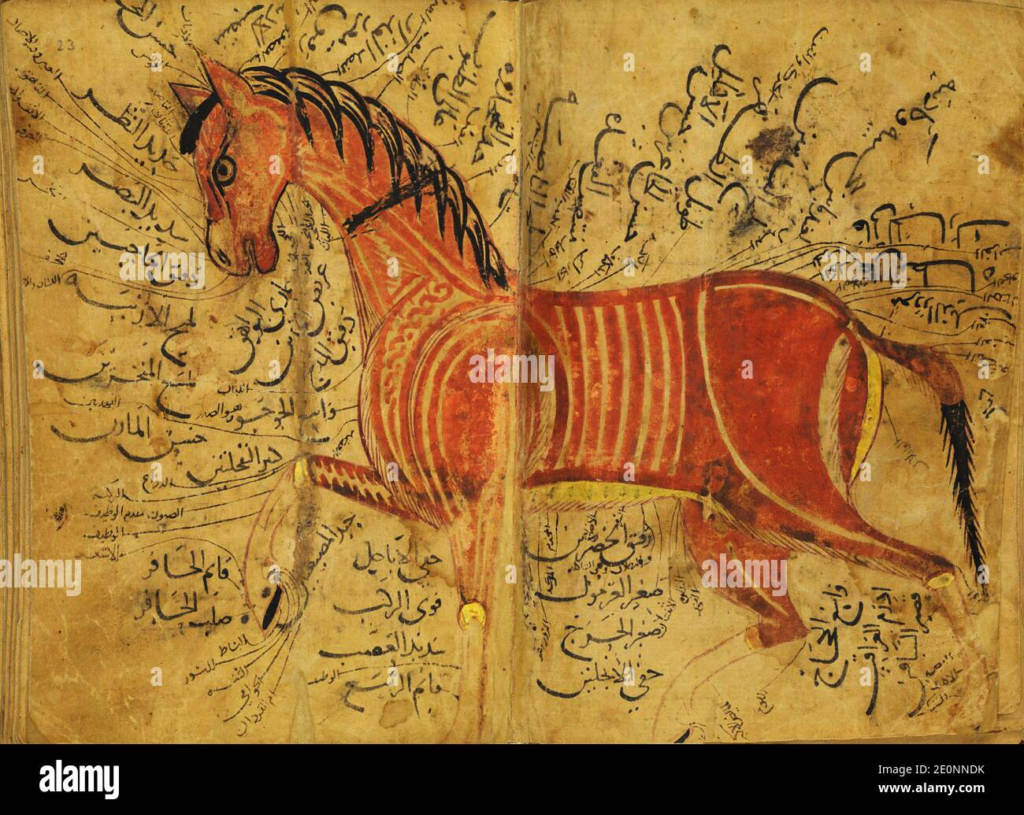On a French translation of Ibn Akhi Hizam’s “Horses and Hippiatry” (9th century CE)
I thoroughly enjoyed reading — and learned a lot from — the short article presenting the ninth century CE treatise of Ibn Akhi Hizam al-Khuttali’s “Book of Horses and Hippiatry” (Kitab al-Khayl wa al-Baytara, its most commonly used Arabic name). This 2021 article by Jamal Hossaini-Hilali and Abdelkrim El Kasri follows their French translation in 2018 of Ibn Akhi Hizam al-Khuttali’s treatise, based on three of the surviving Arabic manuscripts.
Prof. Hossaini-Hilali informs us that Ibn Akhi Hizam was master of the horses (i.e., stud manager, in today’s parlance) for the sixteenth Abbasid Caliph al-Mu’tadid (892-902 CE) in Bagdad, then the economic, scientific and cultural center of the world. His paternal uncle, Hizam (“Ibn Akhi Hizam” means the “son of the brother of Hizam”), was master of the horses for the eighth Abbassid Caliph al-Mu’tasim (833-842 CE), while his father, the senior al-Khuttali, was the head veterinarian for the tenth Abbasid Caliph al-Mutawwakil (847-861 CE). Horse husbandry and management were clearly a family affair in their case.
The first part of his treatise, a lexicographical compendium of names for horse body parts, teeth, colors, markings, behaviors, qualities, etc., draws heavily on Abu ‘Ubaydah (d. 826 CE) Book of the Horse, whom he cites, and perhaps on that of Al-Asma’i (d. 828 CE), whom we doesn’t. The other two parts, on defects and illnesses, and remedies and treatments, respectively, draw on his own professional experience and that of his father, but also on works by earlier Indian and maybe Greek authors too. Ibn Akhi Hizam al-Khuttali’s work is the foundation for all subsequent medieval Arabic-language treatises on hippology and hippiatry.
Pr Jamal Hossaini-Hilali is a Member of the Royal Academy for Veterinary Sciences of Spain, and of the Veterinary Academy of French, and the head of the Department of Biological and Pharmaceutical Veterinary Sciences at the Institut Agronomique et Vétérinaire Hassan II in Morocco. He is happy to engage with readers in the comments thread. His full translation of Ibn Akhi Hizam’s book is available here, for a free download.

“Ibn Akhî Hizâm conseille toujours le cavalier ou le moniteur d’agir avec douceur et amabilité. Ces termes et leurs synonymes reviennent comme un leitmotiv. Pour Ibn Akhî Hizâm, la brutalité envers le cheval est à proscrire totalement” – a theme in equine texts since Xenophon. It also reminds me of a nineteenth century English text I have read and will have to dig up again, which says that Arab horses are sweet-tempered because they never know a harsh word or a blow, while British horse handlers are quick to punish horses.
“Il s’agit d’un traitement de mise en forme pour préparer le cheval à une course, une razzia ou une guerre. La période de cette mise en forme est généralement de 40 jours et l’objectif principal est de faire suer au maximum le cheval pour éliminer les mauvaises humeurs et la graisse. La sudation excessive se fait par l’exercice, l’utilisation des couvertures et des caparaçons” – I want to compare this to the later English texts on the preparation of horses for racing; I am sure there would be some interesting overlap. The running horses and early Thoroughbreds were often exercised in hoods and blankets, to make them sweat their grass weight off. I wonder to what extent mediaeval Arabic hippological treatises influenced later European ones.
And, of course, as a philologist, obligatory shout out to the observation that “sa langue arabe est imprégnée par l’oralité de l’époque”. Something more to read up on!
Where can I find traditional texts on Arabian horsemanship translated into English
A list would be great. I’ve tried searching the internet but haven’t had any luck
You may want to contact Hylke Hettema who knows the answer of your question.